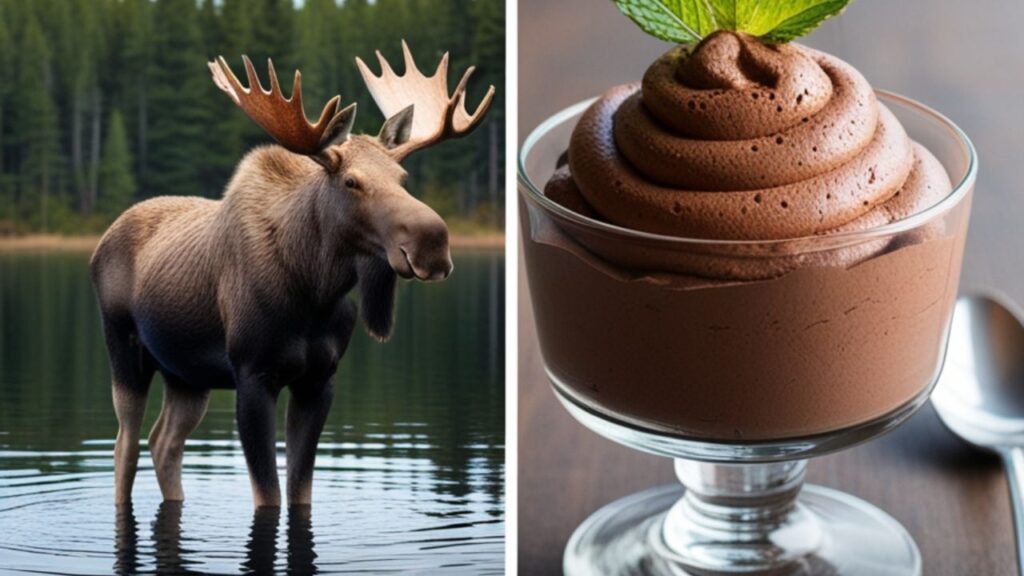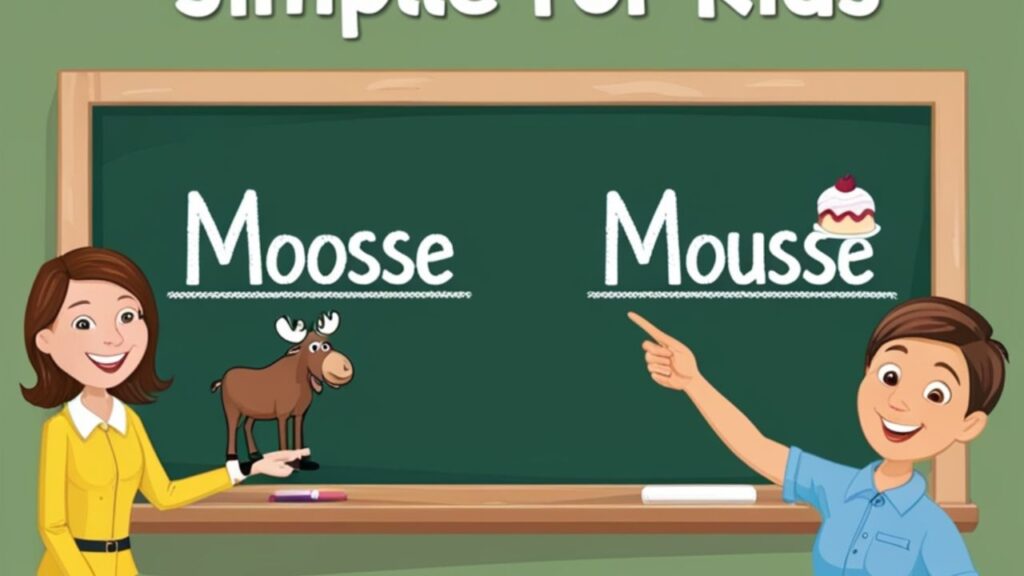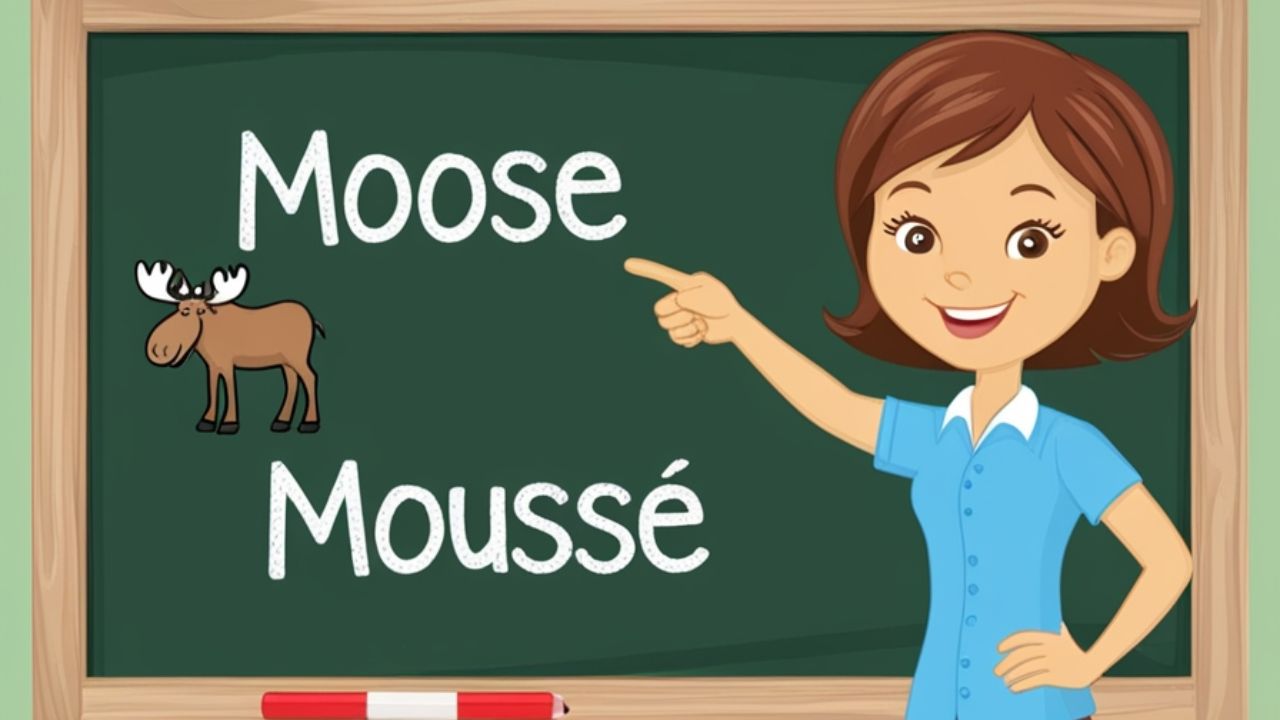A moose is a big animal with long legs and wide antlers. It lives in cold forests and eats leaves, grass, and tree bark. People can see it in countries like Canada and Alaska. It looks calm but stays strong in the wild.
A mousse is a sweet and creamy dessert people love to eat. It’s made with chocolate, fruit, or cream and feels light and soft in your mouth. You can also use hair mousse to make hair fluffy and shiny.
The words moose and mousse sound the same but mean different things. One belongs to the forest, and the other to the kitchen. Knowing this helps you write correctly and speak clearly. It also makes English learning easier and more fun.
Understanding Homophones: Moose and Mousse
Homophones are words that sound the same but mean different things. They can make writing tricky for learners. Words like bare and bear or flour and flower show how English can sound alike yet tell very different stories.
The pair moose and mousse are good examples of homophones. One lives in cold forests, and the other is a soft dessert. Knowing their meanings helps young learners write correctly and understand English words more clearly.
Common Homophone Examples:
A moose is a tall animal with long legs and broad antlers. It lives in cold places like Canada and Alaska. It eats grass, leaves, and plants near water. Its large body and calm walk make it easy to recognize.
A mousse is a soft dessert made with cream, chocolate, or fruits. It feels light and sweet when eaten. Some people also use hair mousse to keep their hair neat and shiny. Both words sound alike but mean different things.
- Bare / Bear – “Bare” means without cover, while “bear” is an animal.
- Flour / Flower – “Flour” is used for baking, and “flower” blooms in gardens.
- Sea / See – “Sea” means ocean, and “see” means to look.
- Sun / Son – “Sun” gives light, while “son” means a male child.
- Right / Write – “Right” means correct, and “write” means to form words.
What Is a Moose?
Spelling and Pronunciation
- Moose is spelled M-O-O-S-E and sounds like “moos.”
- Mousse is spelled M-O-U-S-S-E and sounds the same as “moos.”
- Both words rhyme with “goose.”
- The word moose has only one “s.”
- The word mousse has double “s” and comes from French.
Definition
A moose is a tall animal with long legs and broad antlers. It lives in cold places like Canada and Alaska. It eats grass, leaves, and plants near water. Its large body and calm walk make it easy to recognize.
A mousse is a soft dessert made with cream, chocolate, or fruits. It feels light and sweet when eaten. Some people also use hair mousse to keep their hair neat and shiny. Both words sound alike but mean different things.
- A moose is a tall, wild animal with long legs and wide antlers.
- It lives in cold places like Canada, Alaska, and northern forests.
- A mousse is a soft and fluffy dessert made with cream or chocolate.
- It can also mean a foamy product used to style hair.
- Both words sound the same but have very different meanings.
Origin and Etymology
The word moose came from old Native American languages. It means “he strips off,” showing how the animal pulls bark from trees to eat. Later, French and English speakers started using the same word to describe this big forest creature.
The word mousse came from the French word for “foam.” It entered English long ago through cooking and beauty terms. People used it to name soft desserts and light hair products because both look fluffy and airy like bubbles.
See also Indolence vs Insolence: Key Meanings & Easy Examples
Examples in Sentences
- We saw a moose drinking water near the frozen lake.
- The chef made a sweet mousse with strawberries on top.
- A large moose walked quietly through the snowy forest.
- She used some mousse to make her hair soft and shiny.
- The moose lifted its head proudly as the tourists took photos.
What Is a Mousse?

Spelling and Pronunciation
- The word moose is spelled M-O-O-S-E and sounds like “moos.”
- The word mousse is spelled M-O-U-S-S-E and sounds the same as “moos.”
- Both words rhyme with “goose.”
- Moose has one “s,” and mousse has two “s.”
- Though they sound alike, they belong to different meanings and uses.
Definition
A moose is a tall, strong animal that lives in cold places. It has long legs and large antlers that grow like branches. It eats plants, grass, and leaves near lakes and rivers. People often see it walking quietly through forests.
A mousse is a soft and fluffy dessert made from cream, chocolate, or fruits. It tastes sweet and melts in the mouth. Some people also use hair mousse to make their hair smooth and shiny. Both words sound alike but mean different things.
- A moose is a large animal found in cold forest areas.
- It has long legs, big antlers, and eats plants and leaves.
- A mousse is a creamy, soft dessert made with chocolate or fruit.
- It can also mean a light, foamy product for hair styling.
- Both words sound alike but describe very different things.
Origin and Etymology
The word moose came from the language of Native American tribes. It means “he strips off,” because the animal pulls bark from trees to eat. Later, English speakers began using this word to talk about the tall, gentle forest animal.
The word mousse came from the French word that means “foam.” People started using it to name light desserts and soft hair products. The name fits perfectly because both look fluffy and full of bubbles, just like real foam.
Examples in Sentences
- The moose crossed the river slowly and disappeared into the trees.
- She enjoyed a cold chocolate mousse after dinner.
- A moose stood near the road and watched the passing cars.
- He used some mousse to make his hair stand tall.
- The moose rested under a tree after walking a long distance.
Moose vs. Mousse: Core Differences
Common Mistakes and Real Confusions
Mistakes Seen in the Wild:
- Someone wrote, “The chocolate moose was tasty,” instead of mousse.
- A travel blog said, “We saw a mousse near the cabin,” instead of moose.
- A menu listed “strawberry moose” for dessert by mistake.
- A student typed, “She styled her hair with moose,” confusing the words.
- A funny meme showed a real moose next to a dessert cup labeled mousse.
Examples from Social Media & Forums:
- A user posted, “Can’t wait to eat my chocolate moose tonight!”
- Someone shared, “We saw a mousse walking in the woods!”
- A cooking group member asked, “Is it moose cake or mousse cake?”
- A traveler wrote, “Feeding a wild mousse was amazing!”
- A funny tweet said, “Made a moose for dessert — it ran away!”
Tips to Remember the Difference
Mnemonics
- “The moose roams, the mousse foams.”
- Remember U for Yum – if it has a “u,” it’s something you can eat.
- Think of moose with one “s,” just like nature’s calmness.
- Picture a moose in the forest and mousse in a bowl.
- Imagine the “double s” in mousse as the soft bubbles of foam.
Image Association
- Picture a tall moose standing near a snowy forest lake.
- Imagine a bowl of creamy mousse topped with chocolate curls.
- See a moose eating leaves beside green trees and water.
- Think of fluffy mousse with a spoon ready to taste.
- Visualize a strong moose in nature and a soft mousse in a dessert cup.
Why Moose vs. Mousse Matters
In Real Life:
- Bloggers lose trust when they use the wrong word in titles or posts.
- Students lose marks when mixing similar-sounding words in writing.
- Teachers use real mistakes to explain how spelling changes meaning.
- Copywriters check carefully so brands look professional online.
- Travelers learn word meanings to avoid confusion in signs or guides.
See also Is It Correct to Say ‘For Your Records’? Usage Guide
In SEO:
- Using the wrong word can make search engines show your page to the wrong audience.
- A food blog using “moose recipe” may appear in wildlife searches instead of desserts.
- Correct spelling improves your website’s visibility and ranking.
- Search engines read words carefully, so accuracy builds trust and relevance.
- Clear and correct keywords help readers find your content faster online.
Quick Quiz: Moose or Mousse?

A short quiz helps children learn in a fun way. It uses simple sentences where they choose the right word. This makes it easy to see if they understand the sound-alike words that mean very different things in writing and speaking.
In this quiz, learners fill in blanks with the correct word. It teaches how to match meaning with context. When practiced often, it builds confidence and improves spelling. Learning becomes enjoyable, and mistakes slowly start to disappear.
Answers:
The answers show which word fits best in each sentence. They help learners see how spelling changes meaning. When children check their work, they understand why one word belongs in the forest and another belongs on the dinner table.
Looking at the answers builds good learning habits. It teaches students to read carefully and notice small details. Each correct choice improves confidence and memory. Over time, this practice helps them write clearly and use English with ease.
Common Homophone Pitfalls to Watch Out For
Context Matters: Case Studies
Case Study 1: Cooking Blog Misfire
In Case Study 1, a food writer made a funny spelling mistake. The title said “Chocolate Moose” instead of “Chocolate Mousse.” Readers laughed and felt confused. The small typing error changed the meaning and made the post seem like a joke.
This case study teaches the value of checking words before sharing them. One small spelling slip can cause big confusion. Careful proofreading keeps writing clear and correct. It also helps readers trust the information they read online.
Case Study 2: ESL Classroom Confusion
In Case Study 2, students in an English class laughed when they read a line about fixing hair with “moose.” The teacher explained that the right word was “mousse.” The short talk helped everyone remember the difference easily.
This case study shows how small spelling changes can teach big lessons. Real-life examples make learning fun and easy to understand. Teachers often use such moments to explain confusing words and help students improve their English skills.
Final Thoughts
The final thoughts remind learners that words sounding alike can still mean very different things. Knowing them well helps avoid mistakes in writing and reading. Clear understanding makes English easier and keeps communication smooth and correct.
These final thoughts encourage steady practice. Learning step by step builds strong language skills. Small improvements lead to great confidence. When students study carefully, they gain a better grasp of spelling, meaning, and usage in daily life.
Remember:
- A moose is a strong forest animal with big antlers.
- A mousse is a light, creamy dessert or hair product.
- Both words sound alike but mean very different things.
- Always check the spelling before writing or typing them.
- Clear understanding helps in speaking and writing correctly.
FAQs
Is it moose or mousse?
“Moose” is an animal; “mousse” is a creamy dessert or foamy substance used in hair products.
What are the main differences between mousse and mousseline?
“Mousse” is light and airy; “mousseline” is richer, often blended with cream or butter for smoothness.
How do you spell moose as in dessert mousse?
The dessert is spelled “mousse,” not “moose,” which refers to the large antlered animal.
Is it mousse or mouse?
It’s “mousse” for dessert or foam and “mouse” for the small animal or computer device.

Join Bibcia on a journey to master English grammar. Discover easy lessons, writing tips, and practical examples designed to make learning grammar simple and effective.










